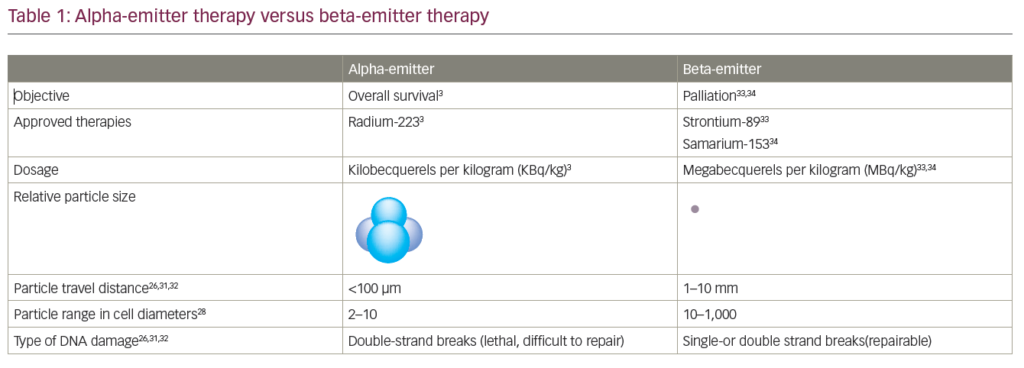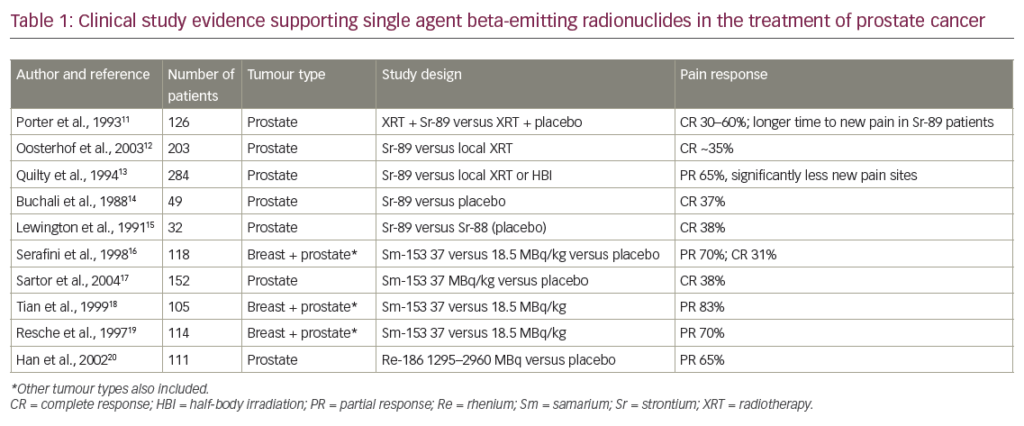Prostate cancer is the most commonly diagnosed malignancy in men. Greyscale ultrasound (US)-guided systematic biopsy is the standard of care for prostate cancer detection in men with elevated prostate serum antigen (PSA) or an abnormal digital rectal examination (DRE). Previous reports have demonstrated that contrast-enhanced US (CEUS) investigations of the blood flow of the prostate allow for prostate cancer visualisation and therefore for targeted biopsies. Comparisons between systematic and CEUS-targeted biopsies have shown that the targeted approach detects more cancers with a lower number of biopsy cores. CEUS has also been shown to detect cancers with higher Gleason scores compared with the systematic approach, which seems to improve prostate cancer grading. This article will discuss the value of CEUS in the imaging of prostate cancer.
Newly developed US contrast agents enable improved detection of low-volume blood flow by increasing the signal-to-noise ratio.1 Therefore, US contrast agents allow for a more complete delineation of the neovascular anatomy by enhancing the signal strength from small vessels (i.e. neovessels). Furthermore, these agents can be used to time the transit of an injected bolus. Unlike radiographic contrast media, which diffuse into the tissue and may obscure smaller vessels, microbubble echo-enhancing agents are confined to the vascular lumen, where they persist until they dissolve. US contrast agents are made of gas bubbles small enough to cross through capillary beds.2
They have two main important acoustic properties: first, they are many times more reflective than blood, thus improving flow detection; and second, their vibrations generate higher harmonics to a much greater degree than surrounding tissues. The half-life of contrast agents is dependent on bubble construction. Bubbles can be free or encapsulated in soft or hard shells. The duration of enhancement after injection may last from a few seconds to many minutes, depending on the bubble type.
Bree at al. demonstrated the potential use of contrast-enhanced colour Doppler to enhance the diagnostic yield in a group of 17 patients with normal greyscale transrectal US and elevated PSA values. Correlation of biopsy sites with colour Doppler US abnormalities revealed a sensitivity of 54%, a specificity of 78%, a positive predictive value (PPV) of 61% and a negative predictive value (NPV) of 72% for the detection of prostate cancer. Three of the cases with a positive contrast-enhanced biopsy site had negative transrectal US random biopsy within the previous year.3
Frauscher et al. examined the use of contrast-enhanced colour Doppler US in 72 patients identified by PSA screening in a previous study. Using a quantitative scale to characterise the degree of vascularity, the technique had a sensitivity of 53%, specificity of 72% and PPV of 70% in distinguishing prostate cancer from benign lesion.4 Previous studies reported the value of contrast-enhanced colour Doppler in a prospective study in 2305 and 380 male screening volunteers,6 and found that targeted biopsies based on contrastenhanced colour Doppler detected as many cancers as systematic biopsies, with less than half the number of biopsy cores.
Bogers et al. evaluated contrast-enhanced 3D transrectal ultrasound imaging of the prostate vasculature with power Doppler. 3D power Doppler images were obtained before and after intravenous (IV) administration of 2.5g Levovist™ (Schering, Berlin). Subsequently, random and/or directed transrectal US (TRUS)-guided biopsies were performed. Prostate vasculature was judged with respect to symmetry and vessel distribution. Eighteen patients with a suspicion of prostate cancer because of either an elevated PSA (greater than 4.0ng/ml; Tandem-R-assay) or an abnormal DRE were included in the study.
Prostate cancer was detected in 13 patients. Vascular anatomy was judged abnormal in unenhanced images in six cases, of which five proved malignant. Enhanced images were considered suspicious for malignancy in 12 cases, including one benign and 11 malignant biopsy results. Sensitivity of enhanced images was 85% (specificity 80%) compared with 38% for unenhanced images (specificity 80%) and 77% for conventional greyscale TRUS (specificity 60%). Among six patients who showed no B mode abnormalities, vascular patterns were judged abnormal in four cases, of which three were malignant. Based on these findings they concluded that contrast-enhanced 3D power Doppler angiography is feasible in patients with suspicion of prostate cancer who are scheduled for prostate biopsies.7
Further analyses by the same group suggested that 3D contrastenhanced power Doppler US is a better diagnostic tool than the DRE, PSA level, greyscale US or power Doppler US alone. The most suitable diagnostic predictor for prostate cancer was a combination of 3D contrast-enhanced power Doppler US and PSA level.8 Sedelaar et al. demonstrated the correlation between microvessel density (MVD) and 3D contrast-enhanced power Doppler imaging.9 In all patients, the enhanced side of the prostate was correlated with a higher MVD count. Concerning the MVD and the colour pixel density, similar results were found using contrast-enhanced colour Doppler US using the US contrast agent Levovist™ (Schering, Berlin).10
Another approach to contrast-enhanced imaging of the prostate is phase or pulse inversion technology to utilise the non-linear behaviour of the bubbles in order to differentiate blood flow echoes from background tissue with high contrast and spatial resolution. Albrecht et al. demonstrated this technique in 39 human subjects. Greyscale enhancement of vessels and organ parenchyma was seen in all cases. Enhancement occurred from both flowing and stationary microbubbles. Flow-independent enhancement of tissue represents a major advance in contrast-enhanced US with many potential applications, especially in tumour imaging.11
In a preliminary study of 26 subjects, Halpern et al. investigated the usefulness of CEUS to depict vascularity in the prostate. Continuous greyscale and intermittent greyscale imaging were performed at the fundamental frequency. Phase-inversion greyscale imaging was available only for the final few subjects in the study. US findings were correlated with sextant biopsy results. After the administration of the contrast material Imagent™ (Alliance Pharmaceutical, San Diego, CA), greyscale and Doppler images revealed visible enhancement (p<0.05). Using intermittent imaging, they found focal enhancement in two isoechoic tumours that were not visible on baseline images. No definite focal area of enhancement was identified in any patient without cancer. Furthermore, contrast-enhanced images revealed obvious enhancement of transient haemorrhage in the biopsy tracts of three patients. They concluded that greyscale, as well as Doppler, enhancement of the prostate can be seen on US images after the administration of an intravenous (IV) contrast agent, and that contrastenhanced intermittent US of the prostate may be useful for the selective enhancement of malignant prostatic tissue.12
In another study the value of intermittent harmonic imaging for prostate cancer detection was assessed. Three hundred and one subjects referred for prostate biopsy were evaluated with contrast-enhanced US using continuous harmonic imaging (CHI) and intermittent harmonic imaging (IHI) with inter-scan delay times of 0.2, 0.5, 1.0 and 2.0 seconds, as well as continuous colour and power Doppler. Targeted biopsy cores were obtained from the sites of greatest enhancement, followed by spatially distributed cores in a modified sextant distribution. Prostate cancer was detected in 363 biopsy cores from 104 of 301 subjects (35%). Prostate cancer was found in 15.5% (175 of 1,133) of targeted cores and 10.4% (188 of 1,806) of sextant cores (p<0.01). Among subjects with carcinoma, targeted cores were twice as likely to be positive. A statistically significant benefit was found for IHI over baseline imaging (p<0.05). Therefore, the prostate cancer detection rate of contrast-enhanced targeted cores was significantly higher compared with sextant cores. Contrast-enhanced transrectal US with IHI provides a statistically significant improvement in
discrimination between benign and malignant biopsy sites.13
In summary, the detection of prostate cancer with CEUS may be improved relative to baseline TRUS. However, based on the relatively small number of published studies, substantial uncertainty remains in the interpretation of contrast-enhanced TRUS images. In one study, 16% (59 of 360) of contrast-enhanced TRUS images were rated as indeterminate with respect to vascular enhancement.14 Future studies of contrastenhanced TRUS should investigate new techniques to optimise the signal from contrast agents in the prostate, and to maximise the difference in signal between benign and malignant tissues. Halpern et al. reported greater enhancement with intermittent imaging and bolus administration of contrast. New imaging techniques may be developed to reduce bubble destruction during imaging. Since the prostate is generally evaluated with a frequency in the range of 5–7.5MHz, newer bubble agents that resonate at higher frequencies may provide a better signal. Alternatively, harmonic imaging at lower frequencies or with subharmonics may be useful with current contrast agents.15 With these new developments, prostate cancer detection may be significantly improved by the use of CEUS, and the current standard of care for prostate cancer detection – the systematic biopsy – may be replaced by a CEUS targeted approach in the future. ■
My Learning
Login
Sign Up FREE
Register Register
Login
Trending Topic

12 mins
Trending Topic
Developed by Touch
Mark CompleteCompleted
BookmarkBookmarked
Allan A Lima Pereira, Gabriel Lenz, Tiago Biachi de Castria
NEW
Despite being considered a rare type of malignancy, constituting only 3% of all gastrointestinal cancers, the incidence of biliary tract cancers (BTCs) has been increasing worldwide in recent years, with about 20,000 new cases annually only in the USA.1–3 These cancers arise from the biliary epithelium of the small ducts in the periphery of the liver […]
touchREVIEWS in Oncology & Haematology. 2025;21(1):Online ahead of journal publication














